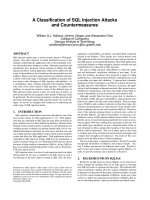SQL Injection
Bạn đang xem bản rút gọn của tài liệu. Xem và tải ngay bản đầy đủ của tài liệu tại đây (250.94 KB, 13 trang )
S
QL injection is yet another common vulnerability that is the result of lax input valida-
tion. Unlike cross-site scripting vulnerabilities that are ultimately directed at your site’s
visitors, SQL injection is an attack on the site itself—in particular its database.
The goal of SQL injection is to insert arbitrary data, most often a database query, into a
string that’s eventually executed by the database. The insidious query may attempt any num-
ber of actions, from retrieving alternate data, to modifying or removing information from the
database.
To demonstrate the problem, consider this excerpt:
// supposed input
$name = “ilia’; DELETE FROM users;”;
mysql_query(“SELECT * FROM users WHERE name=’{$name}’”);
3
SQL Injection
74
SQL Injection
The function call is supposed to retrieve a record from the
users
table where the name col-
umn matches the name specified by the user. Under normal circumstances,
$name
would only
contain alphanumeric characters and perhaps spaces, such as the string
ilia
. But here, by ap-
pending an entirely new query to
$name
, the call to the database turns into disaster: the injected
DELETE
query removes all records from
users
.
MySQL Exception
Fortunately, if you use MySQL, the
mysql_query()
function does not permit query stacking, or executing
multiple queries in a single function call. If you try to stack queries, the call fails.
However, other PHP database extensions, such as SQLite and PostgreSQL, happily perform stacked que-
ries, executing all of the queries provided in one string and creating a serious security problem.
Magic Quotes
Given the potential harm that can be caused by SQL injection, PHP’s automatic input escape
mechanism,
magic_quotes_gpc
, provides some rudimentary protection. If enabled,
magic_
quotes_gpc
, or “magic quotes”, adds a backslash in front of single-quotes, double-quotes, and
other characters that could be used to break out of a value identifier. But, magic quotes is a
generic solution that doesn’t include all of the characters that require escaping, and the fea-
ture isn’t always enabled (for reasons outlined in the first chapter). Ultimately, it’s up to you to
implement safeguards to protect against SQL injection.
To help, many of the database extensions available for PHP include dedicated, custom-
ized escape mechanisms. For example, the MySQL extension for PHP provides the function
mysql_real_escape_string()
to escape input characters that are special to MySQL:
if (get_magic_quotes_gpc()) {
$name = stripslashes($name);
}
$name = mysql_real_escape_string($name);
mysql_query(“SELECT * FROM users WHERE name=’{$name}’”);
However, before calling a database’s own escaping mechanism, it’s important to check the state
of magic quotes. If magic quotes is enabled, remove any backslashes (
\
) it may have added;
otherwise, the input will be doubly-escaped, effectively corrupting it (because it differs from
75SQL Injection
the input supplied by the user).
In addition to securing input, a database-specific escape function prevents data corrup-
tion. For example, the escape function provided in the MySQL extension is aware of connection
characters and encodes those (and others) to ensure that data isn’t corrupted by the MySQL
storage mechanism and vice versa.
Native escape functions are also invaluable for storing binary data: left “unescaped”, some
binary data may conflict with the database’s own storage format, leading to the corruption or
loss of a table or the entire database. Some database systems, such as PostgreSQL, offer a dedi-
cated function to encode binary data. Rather than escape problematic characters, the function
applies an internal encoding. For instance, PostgreSQL’s
pg_escape_bytea()
function applies a
Base64-like encoding to binary data:
// for plain-text data use:
pg_escape_string($regular_strings);
// for binary data use:
pg_escape_bytea($binary_data);
A binary data escaping mechanism should also be used to process multi-byte languages that
aren’t supported natively by the database system. (Multi-byte languages such as Japanese use
multiple bytes to represent a single character; some of those bytes overlap with the ASCII range
normally only used by binary data.)
There’s a disadvantage to encoding binary data: it prevents persisted data from being
searched other than by a direct match. This means that a partial match query such as
LIKE
‘foo%’
won’t work, since the encoded value stored in the database won’t necessarily match the
initial encoded portion looked for by the query.
For most applications, though, this limitation isn’t a major problem, as partial searches
are generally reserved for human readable data and not binary data, such as images and com-
pressed files.
Prepared Statements
While database-specific escape functions are useful, not all databases provide such a feature.
In fact, database-specific escape functions are relatively rare. (At the moment) only MySQL,
PostgreSQL, SQLite, Sybase, and MaxDB extensions provide them. For other databases, includ-
76
SQL Injection
ing Oracle, Microsoft SQL Server, and others, an alternate solution is required.
A common technique is to Base64-encode all values passed to the database, thus pre-
venting any special characters from corrupting the underlying store or causing trouble. But
Base64-encoding expands data roughly 33 percent, requiring larger columns and more storage
space. Furthermore, Base64-encoded data has the same problem as binary encoded data in
PostgreSQL: it cannot be searched with
LIKE
. Clearly a better solution is needed—something
that prevents incoming data from affecting the syntax of the query.
Prepared queries (also called prepared statements) solve a great many of the aforemen-
tioned risks. Prepared queries are query “templates”: the structure of the query is pre-defined
and fixed and includes placeholders that stand-in for real data. The placeholders are typically
type-specific—for example,
int
for integer data and
text
for strings—which allows the da-
tabase to interpret the data strictly. For instance, a text placeholder is always interpreted as
a literal, avoiding exploits such as the query stacking SQL injection. A mismatch between a
placeholder’s type and its incoming datum cause, execution errors, adding further validation
to the query.
In addition to enhancing query safety, prepared queries improve performance. Each pre-
pared query is parsed and compiled once, but can be re-used over and over. If you need to
perform an
INSERT
en masse, a pre-compiled query can save valuable execution time.
Preparing a query is fairly simple. Here is an example:
pg_query($conn, “PREPARE stmt_name (text) AS SELECT * FROM users WHERE name=$1”);
pg_query($conn, “EXECUTE stmt_name ({$name})”);
pg_query($conn, “DEALLOCATE stmt_name”);
PREPARE stmt_name (text) AS
... creates a prepared query named
stmt_name
that expects
one
text
value. Everything following the keyword
AS
defines the actual query, except
$1
is the
placeholder for the expected
text
.
If a prepared statement expects more than one value, list each type in order, separated by
a comma, and use
$1
,
$2
, and so on for each placeholder, as in
PREPARE stmt_example (text,
int) AS SELECT * FROM users WHERE name=$1 AND id=$2
.
Once compiled with
PREPARE
, you can run the prepared query with
EXECUTE
. Specify two
arguments: the name of the prepared statement (such as
stmt_name
) to run and a list of actual
values enclosed in parentheses.
Once you’re finished with the prepared statement, dispose of it with
DEALLOCATE
. Forget-
77SQL Injection
ting to jettison prepared queries can cause future
PREPARE
queries to fail.This is a common
error when persistent database connections are used, where a statement can persist across
requests. For example, Given that there is no way to check if a statement exists or not, a blind
attempt to create one anyway will trigger a query error if one is already present.
As nice as prepared queries are, not all databases support them; in those instances escap-
ing mechanisms should be used.
No Means of Escape
Alas, escape functions do not always guarantee data safety. Certain queries can still permit SQL
injection, even after escapes are applied.
Consider the following situation, where a query expects an integer value:
$id = “0; DELETE FROM users”;
$id = mysql_real_escape_string($id); // 0; DELETE FROM users
mysql_query(“SELECT * FROM users WHERE id={$id}”);
When executing integer expressions, it’s not necessary to enclose the value inside single quotes.
Consequently, the semicolon character is sufficient to terminate the query and inject an addi-
tional query. Since the semicolon doesn’t have any “special” meaning, it’s left as-is by both the
database escape function and
addslashes()
.
There are two possible solutions to the problem.
The first requires you to quote all arguments. Since single quotes are always escaped, this
technique prevents SQL injection. However, quoting still passes the user input to the database,
which is likely to reject the query. Here is an illustrative example:
$id = “0; DELETE FROM users”;
$id = pg_escape_string($id); // 0; DELETE FROM users
pg_query($conn, “SELECT * FROM users WHERE id=’{$id}’”)
or die(pg_last_error($conn));
// will print invalid input syntax for integer: “0; DELETE FROM users”
But query failures are easily avoided, especially when validation of the query arguments is so
simple. Rather than pass bogus values to the database, use a PHP cast to ensure each datum









